Preventing Cardiovascular Disorders - Guidelines and Action Plans
VerifiedAdded on 2023/01/18
|13
|3968
|71
AI Summary
This assignment focuses on developing a policy to spread awareness and help people prevent the occurrence of cardiovascular disorders by adopting proper lifestyle choices. It discusses the prevalence of cardiovascular disorders in Australia, risk factors, reasons for considering it a major health concern, and action plans to control its prevalence.
Contribute Materials
Your contribution can guide someone’s learning journey. Share your
documents today.

Running head: POLICY DEVELOPMENT
POLICY DEVELOPMENT
Name of the student:
Name of the university:
Author note:
POLICY DEVELOPMENT
Name of the student:
Name of the university:
Author note:
Secure Best Marks with AI Grader
Need help grading? Try our AI Grader for instant feedback on your assignments.
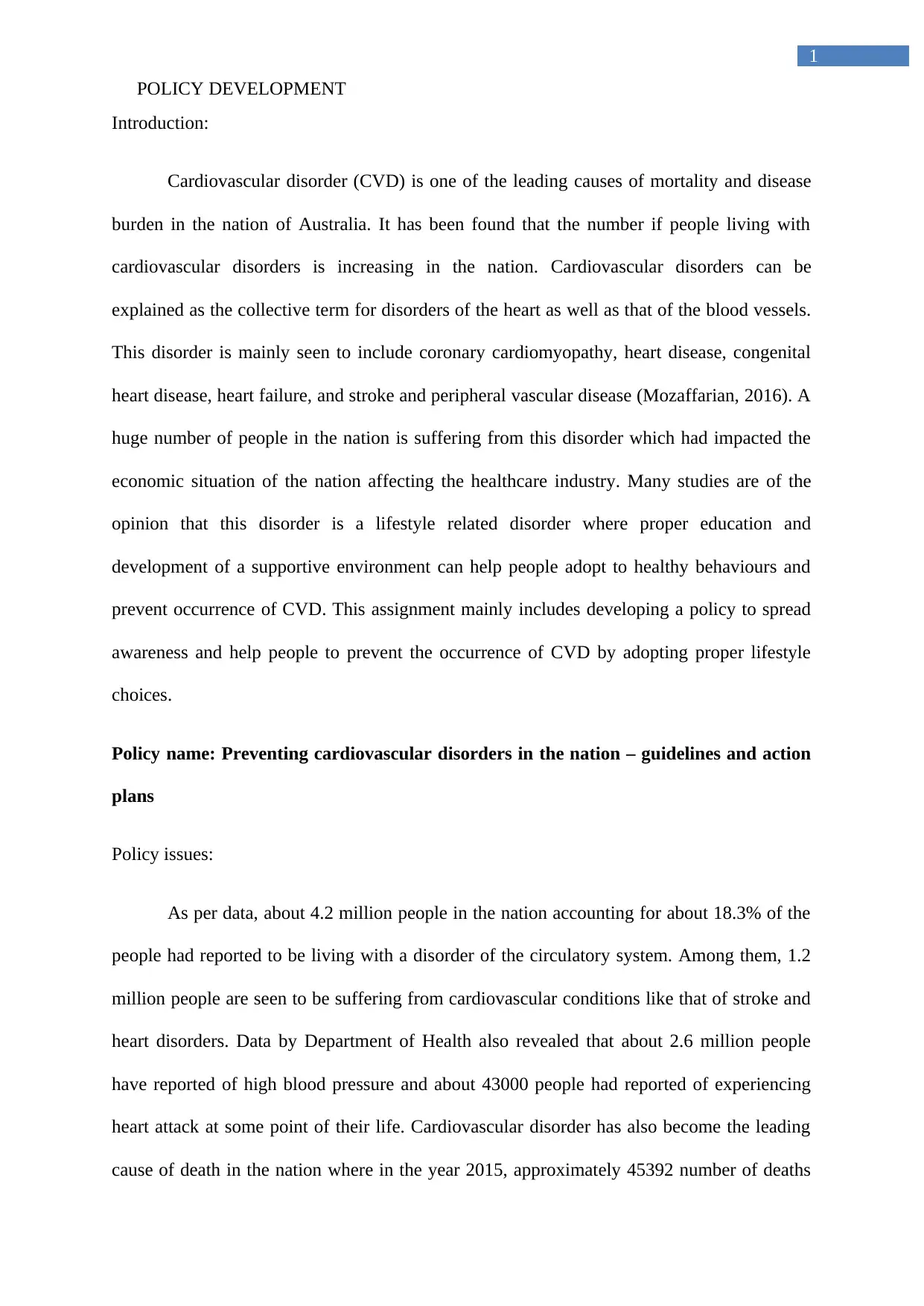
1
POLICY DEVELOPMENT
Introduction:
Cardiovascular disorder (CVD) is one of the leading causes of mortality and disease
burden in the nation of Australia. It has been found that the number if people living with
cardiovascular disorders is increasing in the nation. Cardiovascular disorders can be
explained as the collective term for disorders of the heart as well as that of the blood vessels.
This disorder is mainly seen to include coronary cardiomyopathy, heart disease, congenital
heart disease, heart failure, and stroke and peripheral vascular disease (Mozaffarian, 2016). A
huge number of people in the nation is suffering from this disorder which had impacted the
economic situation of the nation affecting the healthcare industry. Many studies are of the
opinion that this disorder is a lifestyle related disorder where proper education and
development of a supportive environment can help people adopt to healthy behaviours and
prevent occurrence of CVD. This assignment mainly includes developing a policy to spread
awareness and help people to prevent the occurrence of CVD by adopting proper lifestyle
choices.
Policy name: Preventing cardiovascular disorders in the nation – guidelines and action
plans
Policy issues:
As per data, about 4.2 million people in the nation accounting for about 18.3% of the
people had reported to be living with a disorder of the circulatory system. Among them, 1.2
million people are seen to be suffering from cardiovascular conditions like that of stroke and
heart disorders. Data by Department of Health also revealed that about 2.6 million people
have reported of high blood pressure and about 43000 people had reported of experiencing
heart attack at some point of their life. Cardiovascular disorder has also become the leading
cause of death in the nation where in the year 2015, approximately 45392 number of deaths
POLICY DEVELOPMENT
Introduction:
Cardiovascular disorder (CVD) is one of the leading causes of mortality and disease
burden in the nation of Australia. It has been found that the number if people living with
cardiovascular disorders is increasing in the nation. Cardiovascular disorders can be
explained as the collective term for disorders of the heart as well as that of the blood vessels.
This disorder is mainly seen to include coronary cardiomyopathy, heart disease, congenital
heart disease, heart failure, and stroke and peripheral vascular disease (Mozaffarian, 2016). A
huge number of people in the nation is suffering from this disorder which had impacted the
economic situation of the nation affecting the healthcare industry. Many studies are of the
opinion that this disorder is a lifestyle related disorder where proper education and
development of a supportive environment can help people adopt to healthy behaviours and
prevent occurrence of CVD. This assignment mainly includes developing a policy to spread
awareness and help people to prevent the occurrence of CVD by adopting proper lifestyle
choices.
Policy name: Preventing cardiovascular disorders in the nation – guidelines and action
plans
Policy issues:
As per data, about 4.2 million people in the nation accounting for about 18.3% of the
people had reported to be living with a disorder of the circulatory system. Among them, 1.2
million people are seen to be suffering from cardiovascular conditions like that of stroke and
heart disorders. Data by Department of Health also revealed that about 2.6 million people
have reported of high blood pressure and about 43000 people had reported of experiencing
heart attack at some point of their life. Cardiovascular disorder has also become the leading
cause of death in the nation where in the year 2015, approximately 45392 number of deaths
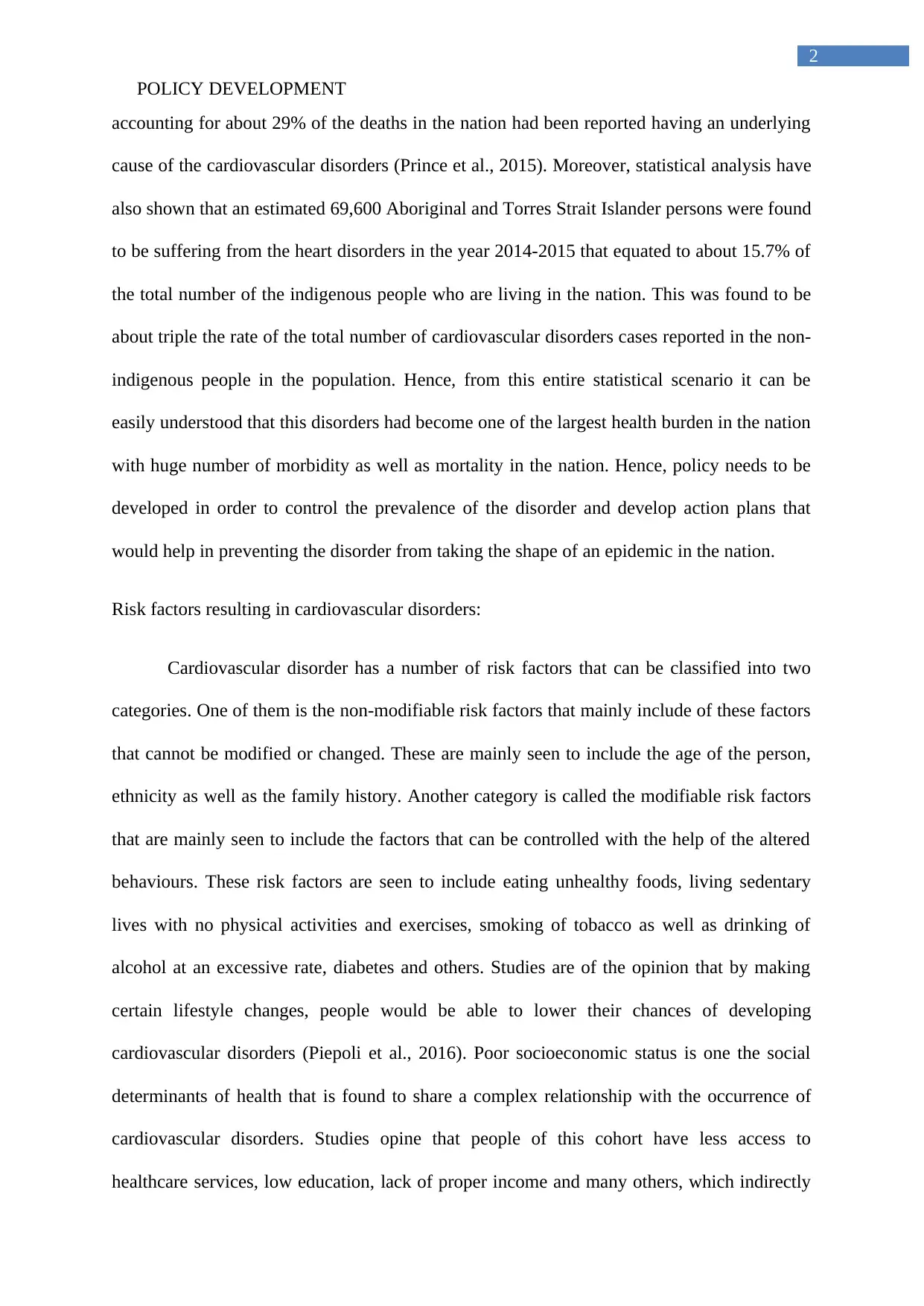
2
POLICY DEVELOPMENT
accounting for about 29% of the deaths in the nation had been reported having an underlying
cause of the cardiovascular disorders (Prince et al., 2015). Moreover, statistical analysis have
also shown that an estimated 69,600 Aboriginal and Torres Strait Islander persons were found
to be suffering from the heart disorders in the year 2014-2015 that equated to about 15.7% of
the total number of the indigenous people who are living in the nation. This was found to be
about triple the rate of the total number of cardiovascular disorders cases reported in the non-
indigenous people in the population. Hence, from this entire statistical scenario it can be
easily understood that this disorders had become one of the largest health burden in the nation
with huge number of morbidity as well as mortality in the nation. Hence, policy needs to be
developed in order to control the prevalence of the disorder and develop action plans that
would help in preventing the disorder from taking the shape of an epidemic in the nation.
Risk factors resulting in cardiovascular disorders:
Cardiovascular disorder has a number of risk factors that can be classified into two
categories. One of them is the non-modifiable risk factors that mainly include of these factors
that cannot be modified or changed. These are mainly seen to include the age of the person,
ethnicity as well as the family history. Another category is called the modifiable risk factors
that are mainly seen to include the factors that can be controlled with the help of the altered
behaviours. These risk factors are seen to include eating unhealthy foods, living sedentary
lives with no physical activities and exercises, smoking of tobacco as well as drinking of
alcohol at an excessive rate, diabetes and others. Studies are of the opinion that by making
certain lifestyle changes, people would be able to lower their chances of developing
cardiovascular disorders (Piepoli et al., 2016). Poor socioeconomic status is one the social
determinants of health that is found to share a complex relationship with the occurrence of
cardiovascular disorders. Studies opine that people of this cohort have less access to
healthcare services, low education, lack of proper income and many others, which indirectly
POLICY DEVELOPMENT
accounting for about 29% of the deaths in the nation had been reported having an underlying
cause of the cardiovascular disorders (Prince et al., 2015). Moreover, statistical analysis have
also shown that an estimated 69,600 Aboriginal and Torres Strait Islander persons were found
to be suffering from the heart disorders in the year 2014-2015 that equated to about 15.7% of
the total number of the indigenous people who are living in the nation. This was found to be
about triple the rate of the total number of cardiovascular disorders cases reported in the non-
indigenous people in the population. Hence, from this entire statistical scenario it can be
easily understood that this disorders had become one of the largest health burden in the nation
with huge number of morbidity as well as mortality in the nation. Hence, policy needs to be
developed in order to control the prevalence of the disorder and develop action plans that
would help in preventing the disorder from taking the shape of an epidemic in the nation.
Risk factors resulting in cardiovascular disorders:
Cardiovascular disorder has a number of risk factors that can be classified into two
categories. One of them is the non-modifiable risk factors that mainly include of these factors
that cannot be modified or changed. These are mainly seen to include the age of the person,
ethnicity as well as the family history. Another category is called the modifiable risk factors
that are mainly seen to include the factors that can be controlled with the help of the altered
behaviours. These risk factors are seen to include eating unhealthy foods, living sedentary
lives with no physical activities and exercises, smoking of tobacco as well as drinking of
alcohol at an excessive rate, diabetes and others. Studies are of the opinion that by making
certain lifestyle changes, people would be able to lower their chances of developing
cardiovascular disorders (Piepoli et al., 2016). Poor socioeconomic status is one the social
determinants of health that is found to share a complex relationship with the occurrence of
cardiovascular disorders. Studies opine that people of this cohort have less access to
healthcare services, low education, lack of proper income and many others, which indirectly
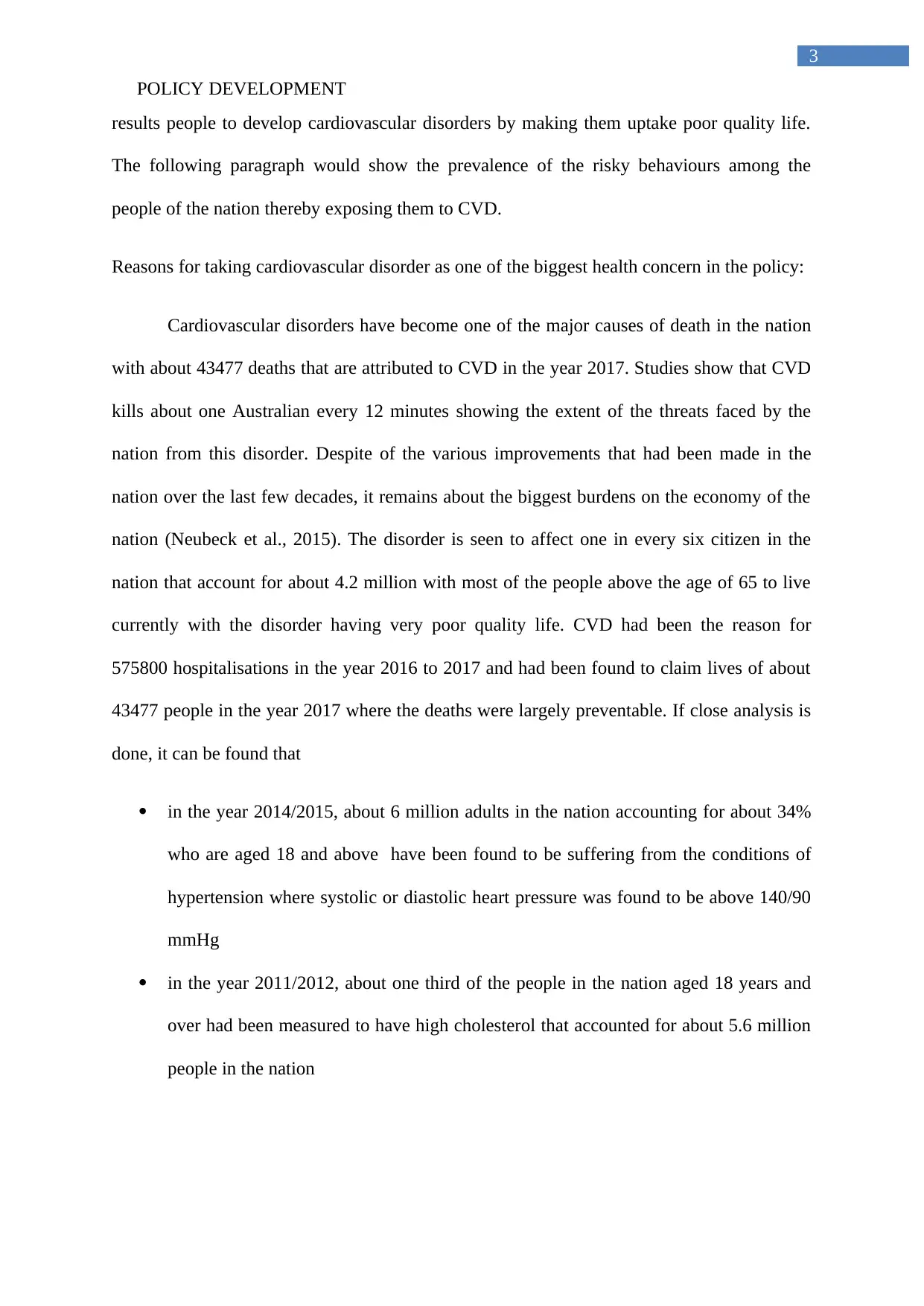
3
POLICY DEVELOPMENT
results people to develop cardiovascular disorders by making them uptake poor quality life.
The following paragraph would show the prevalence of the risky behaviours among the
people of the nation thereby exposing them to CVD.
Reasons for taking cardiovascular disorder as one of the biggest health concern in the policy:
Cardiovascular disorders have become one of the major causes of death in the nation
with about 43477 deaths that are attributed to CVD in the year 2017. Studies show that CVD
kills about one Australian every 12 minutes showing the extent of the threats faced by the
nation from this disorder. Despite of the various improvements that had been made in the
nation over the last few decades, it remains about the biggest burdens on the economy of the
nation (Neubeck et al., 2015). The disorder is seen to affect one in every six citizen in the
nation that account for about 4.2 million with most of the people above the age of 65 to live
currently with the disorder having very poor quality life. CVD had been the reason for
575800 hospitalisations in the year 2016 to 2017 and had been found to claim lives of about
43477 people in the year 2017 where the deaths were largely preventable. If close analysis is
done, it can be found that
in the year 2014/2015, about 6 million adults in the nation accounting for about 34%
who are aged 18 and above have been found to be suffering from the conditions of
hypertension where systolic or diastolic heart pressure was found to be above 140/90
mmHg
in the year 2011/2012, about one third of the people in the nation aged 18 years and
over had been measured to have high cholesterol that accounted for about 5.6 million
people in the nation
POLICY DEVELOPMENT
results people to develop cardiovascular disorders by making them uptake poor quality life.
The following paragraph would show the prevalence of the risky behaviours among the
people of the nation thereby exposing them to CVD.
Reasons for taking cardiovascular disorder as one of the biggest health concern in the policy:
Cardiovascular disorders have become one of the major causes of death in the nation
with about 43477 deaths that are attributed to CVD in the year 2017. Studies show that CVD
kills about one Australian every 12 minutes showing the extent of the threats faced by the
nation from this disorder. Despite of the various improvements that had been made in the
nation over the last few decades, it remains about the biggest burdens on the economy of the
nation (Neubeck et al., 2015). The disorder is seen to affect one in every six citizen in the
nation that account for about 4.2 million with most of the people above the age of 65 to live
currently with the disorder having very poor quality life. CVD had been the reason for
575800 hospitalisations in the year 2016 to 2017 and had been found to claim lives of about
43477 people in the year 2017 where the deaths were largely preventable. If close analysis is
done, it can be found that
in the year 2014/2015, about 6 million adults in the nation accounting for about 34%
who are aged 18 and above have been found to be suffering from the conditions of
hypertension where systolic or diastolic heart pressure was found to be above 140/90
mmHg
in the year 2011/2012, about one third of the people in the nation aged 18 years and
over had been measured to have high cholesterol that accounted for about 5.6 million
people in the nation
Secure Best Marks with AI Grader
Need help grading? Try our AI Grader for instant feedback on your assignments.
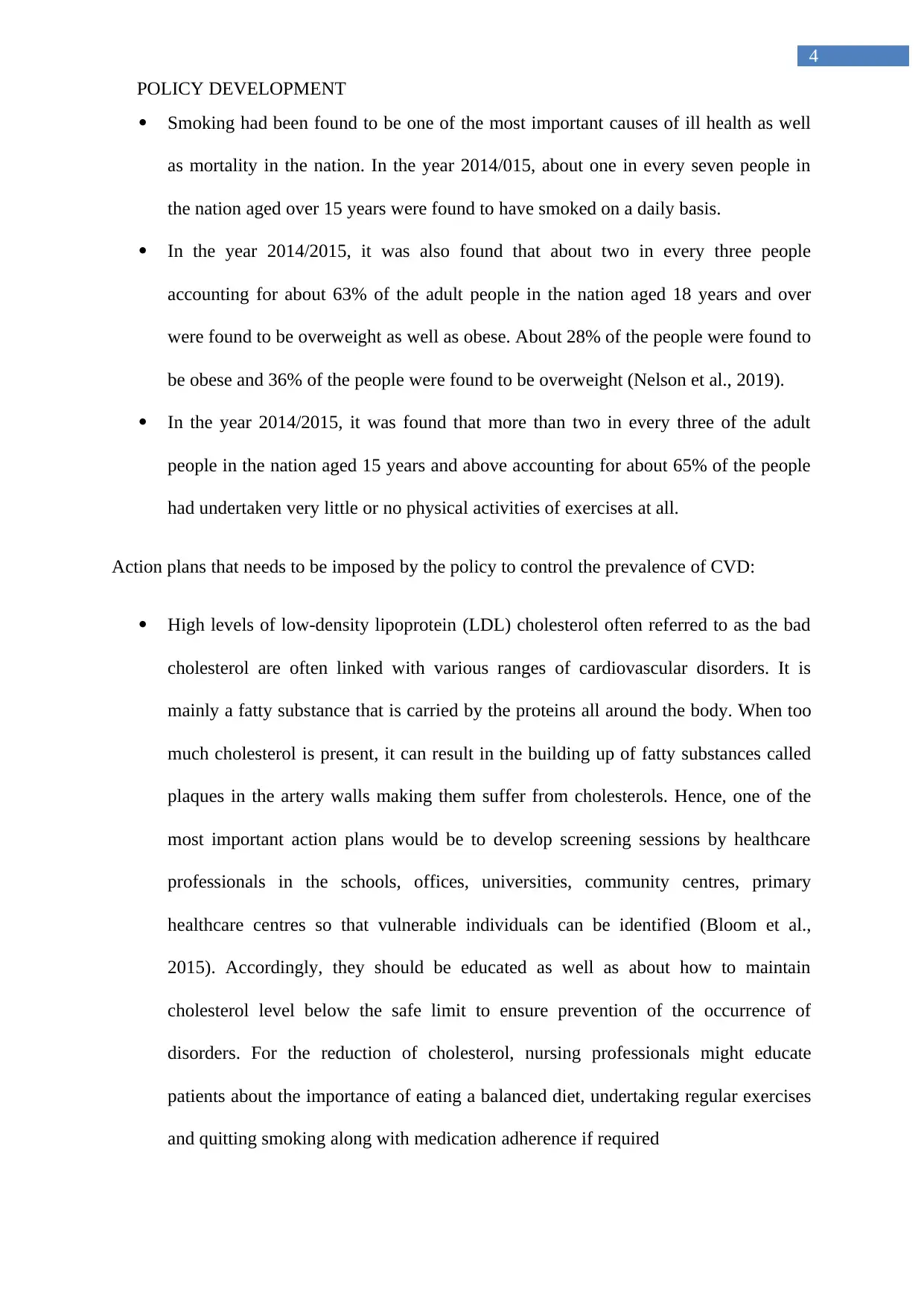
4
POLICY DEVELOPMENT
Smoking had been found to be one of the most important causes of ill health as well
as mortality in the nation. In the year 2014/015, about one in every seven people in
the nation aged over 15 years were found to have smoked on a daily basis.
In the year 2014/2015, it was also found that about two in every three people
accounting for about 63% of the adult people in the nation aged 18 years and over
were found to be overweight as well as obese. About 28% of the people were found to
be obese and 36% of the people were found to be overweight (Nelson et al., 2019).
In the year 2014/2015, it was found that more than two in every three of the adult
people in the nation aged 15 years and above accounting for about 65% of the people
had undertaken very little or no physical activities of exercises at all.
Action plans that needs to be imposed by the policy to control the prevalence of CVD:
High levels of low-density lipoprotein (LDL) cholesterol often referred to as the bad
cholesterol are often linked with various ranges of cardiovascular disorders. It is
mainly a fatty substance that is carried by the proteins all around the body. When too
much cholesterol is present, it can result in the building up of fatty substances called
plaques in the artery walls making them suffer from cholesterols. Hence, one of the
most important action plans would be to develop screening sessions by healthcare
professionals in the schools, offices, universities, community centres, primary
healthcare centres so that vulnerable individuals can be identified (Bloom et al.,
2015). Accordingly, they should be educated as well as about how to maintain
cholesterol level below the safe limit to ensure prevention of the occurrence of
disorders. For the reduction of cholesterol, nursing professionals might educate
patients about the importance of eating a balanced diet, undertaking regular exercises
and quitting smoking along with medication adherence if required
POLICY DEVELOPMENT
Smoking had been found to be one of the most important causes of ill health as well
as mortality in the nation. In the year 2014/015, about one in every seven people in
the nation aged over 15 years were found to have smoked on a daily basis.
In the year 2014/2015, it was also found that about two in every three people
accounting for about 63% of the adult people in the nation aged 18 years and over
were found to be overweight as well as obese. About 28% of the people were found to
be obese and 36% of the people were found to be overweight (Nelson et al., 2019).
In the year 2014/2015, it was found that more than two in every three of the adult
people in the nation aged 15 years and above accounting for about 65% of the people
had undertaken very little or no physical activities of exercises at all.
Action plans that needs to be imposed by the policy to control the prevalence of CVD:
High levels of low-density lipoprotein (LDL) cholesterol often referred to as the bad
cholesterol are often linked with various ranges of cardiovascular disorders. It is
mainly a fatty substance that is carried by the proteins all around the body. When too
much cholesterol is present, it can result in the building up of fatty substances called
plaques in the artery walls making them suffer from cholesterols. Hence, one of the
most important action plans would be to develop screening sessions by healthcare
professionals in the schools, offices, universities, community centres, primary
healthcare centres so that vulnerable individuals can be identified (Bloom et al.,
2015). Accordingly, they should be educated as well as about how to maintain
cholesterol level below the safe limit to ensure prevention of the occurrence of
disorders. For the reduction of cholesterol, nursing professionals might educate
patients about the importance of eating a balanced diet, undertaking regular exercises
and quitting smoking along with medication adherence if required

5
POLICY DEVELOPMENT
High bloods pressure or hypertension is another contributing factor for different
cardiovascular disorders that included stroke, heart failures as well as heart attack.
This should be also diagnosed in the screening session in the different communities,
offices, primary care centres or others with the help of routine test. The professionals
can develop health promotion sessions where they can educate people about
hypertension and how it acts as risk factors for the CVD. High blood pressure is seen
to be linked with being overweight and living sedentary lives along with intake of salt
and alcohol. Nurses should undertake motivational interviews besides health
education sessions to help individuals develop motivations for undertaking lifestyle
changes that would help in reduction of high blood pressure and in severe cases
medication can be prescribed (Banks et al., 2016)
Diabetes is yet other risk factors where high levels of glucose act as the risk factor for
developing CVD. Studies suggest that high levels of glucose can cause damage to the
artery walls resulting in developing cardiovascular disorders by resulting in building
up of fatty deposits in the blood vessels. Hence, diabetes patients should be advised to
have checkups in frequent manners to develop ideas about the conditions of blood
vessels and analysing their vulnerability to develop the disorder. Professionals should
advise every diabetes patients to be careful with their diets and lifestyle choices and
advise them to be active. This would help both the disorders to be kept under control.
Smoking tobacco increases the chance of developing cardiovascular disorders as it
damages and even narrows the arteries resulting in the occurrence of the heart attack
and angina pectoris (Sahle et al., 2016). Nicotine makes the heartbeat as a much faster
rate thereby increasing the blood pressure making the heart work harder to pump
blood around the body. Policy makers will be working with those healthcare
professionals in developing health promotion strategies by which they can motivate
POLICY DEVELOPMENT
High bloods pressure or hypertension is another contributing factor for different
cardiovascular disorders that included stroke, heart failures as well as heart attack.
This should be also diagnosed in the screening session in the different communities,
offices, primary care centres or others with the help of routine test. The professionals
can develop health promotion sessions where they can educate people about
hypertension and how it acts as risk factors for the CVD. High blood pressure is seen
to be linked with being overweight and living sedentary lives along with intake of salt
and alcohol. Nurses should undertake motivational interviews besides health
education sessions to help individuals develop motivations for undertaking lifestyle
changes that would help in reduction of high blood pressure and in severe cases
medication can be prescribed (Banks et al., 2016)
Diabetes is yet other risk factors where high levels of glucose act as the risk factor for
developing CVD. Studies suggest that high levels of glucose can cause damage to the
artery walls resulting in developing cardiovascular disorders by resulting in building
up of fatty deposits in the blood vessels. Hence, diabetes patients should be advised to
have checkups in frequent manners to develop ideas about the conditions of blood
vessels and analysing their vulnerability to develop the disorder. Professionals should
advise every diabetes patients to be careful with their diets and lifestyle choices and
advise them to be active. This would help both the disorders to be kept under control.
Smoking tobacco increases the chance of developing cardiovascular disorders as it
damages and even narrows the arteries resulting in the occurrence of the heart attack
and angina pectoris (Sahle et al., 2016). Nicotine makes the heartbeat as a much faster
rate thereby increasing the blood pressure making the heart work harder to pump
blood around the body. Policy makers will be working with those healthcare
professionals in developing health promotion strategies by which they can motivate
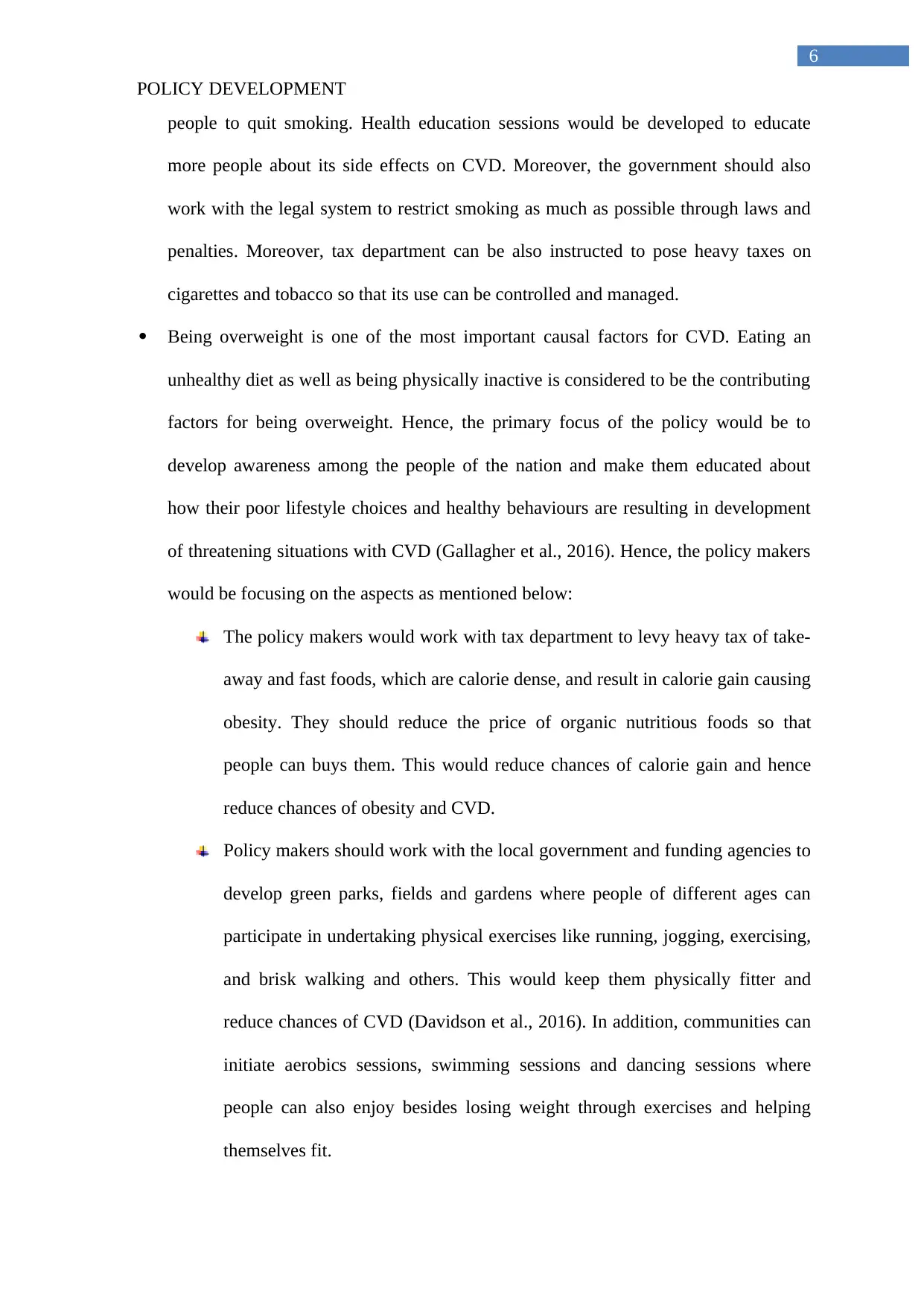
6
POLICY DEVELOPMENT
people to quit smoking. Health education sessions would be developed to educate
more people about its side effects on CVD. Moreover, the government should also
work with the legal system to restrict smoking as much as possible through laws and
penalties. Moreover, tax department can be also instructed to pose heavy taxes on
cigarettes and tobacco so that its use can be controlled and managed.
Being overweight is one of the most important causal factors for CVD. Eating an
unhealthy diet as well as being physically inactive is considered to be the contributing
factors for being overweight. Hence, the primary focus of the policy would be to
develop awareness among the people of the nation and make them educated about
how their poor lifestyle choices and healthy behaviours are resulting in development
of threatening situations with CVD (Gallagher et al., 2016). Hence, the policy makers
would be focusing on the aspects as mentioned below:
The policy makers would work with tax department to levy heavy tax of take-
away and fast foods, which are calorie dense, and result in calorie gain causing
obesity. They should reduce the price of organic nutritious foods so that
people can buys them. This would reduce chances of calorie gain and hence
reduce chances of obesity and CVD.
Policy makers should work with the local government and funding agencies to
develop green parks, fields and gardens where people of different ages can
participate in undertaking physical exercises like running, jogging, exercising,
and brisk walking and others. This would keep them physically fitter and
reduce chances of CVD (Davidson et al., 2016). In addition, communities can
initiate aerobics sessions, swimming sessions and dancing sessions where
people can also enjoy besides losing weight through exercises and helping
themselves fit.
POLICY DEVELOPMENT
people to quit smoking. Health education sessions would be developed to educate
more people about its side effects on CVD. Moreover, the government should also
work with the legal system to restrict smoking as much as possible through laws and
penalties. Moreover, tax department can be also instructed to pose heavy taxes on
cigarettes and tobacco so that its use can be controlled and managed.
Being overweight is one of the most important causal factors for CVD. Eating an
unhealthy diet as well as being physically inactive is considered to be the contributing
factors for being overweight. Hence, the primary focus of the policy would be to
develop awareness among the people of the nation and make them educated about
how their poor lifestyle choices and healthy behaviours are resulting in development
of threatening situations with CVD (Gallagher et al., 2016). Hence, the policy makers
would be focusing on the aspects as mentioned below:
The policy makers would work with tax department to levy heavy tax of take-
away and fast foods, which are calorie dense, and result in calorie gain causing
obesity. They should reduce the price of organic nutritious foods so that
people can buys them. This would reduce chances of calorie gain and hence
reduce chances of obesity and CVD.
Policy makers should work with the local government and funding agencies to
develop green parks, fields and gardens where people of different ages can
participate in undertaking physical exercises like running, jogging, exercising,
and brisk walking and others. This would keep them physically fitter and
reduce chances of CVD (Davidson et al., 2016). In addition, communities can
initiate aerobics sessions, swimming sessions and dancing sessions where
people can also enjoy besides losing weight through exercises and helping
themselves fit.
Paraphrase This Document
Need a fresh take? Get an instant paraphrase of this document with our AI Paraphraser
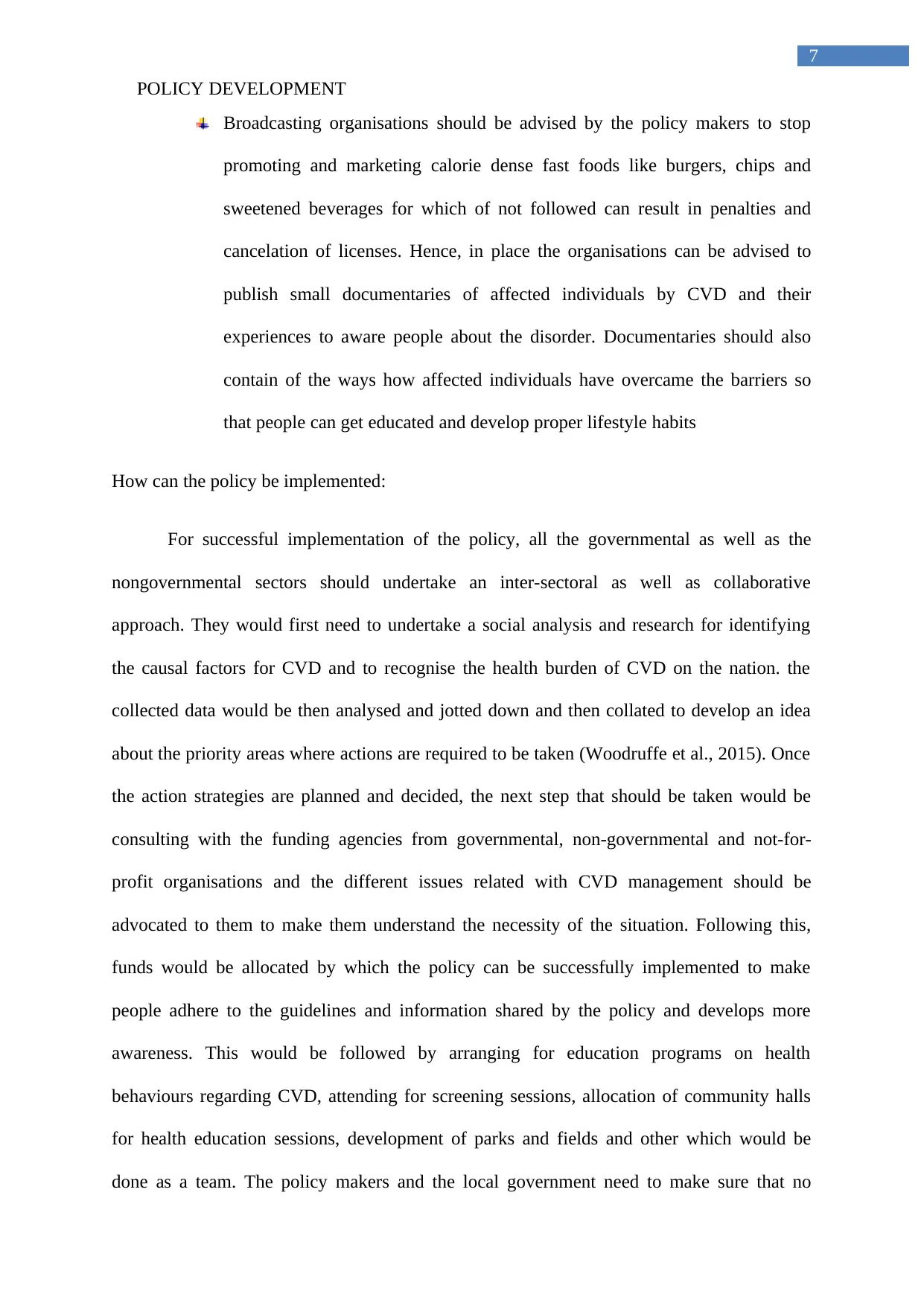
7
POLICY DEVELOPMENT
Broadcasting organisations should be advised by the policy makers to stop
promoting and marketing calorie dense fast foods like burgers, chips and
sweetened beverages for which of not followed can result in penalties and
cancelation of licenses. Hence, in place the organisations can be advised to
publish small documentaries of affected individuals by CVD and their
experiences to aware people about the disorder. Documentaries should also
contain of the ways how affected individuals have overcame the barriers so
that people can get educated and develop proper lifestyle habits
How can the policy be implemented:
For successful implementation of the policy, all the governmental as well as the
nongovernmental sectors should undertake an inter-sectoral as well as collaborative
approach. They would first need to undertake a social analysis and research for identifying
the causal factors for CVD and to recognise the health burden of CVD on the nation. the
collected data would be then analysed and jotted down and then collated to develop an idea
about the priority areas where actions are required to be taken (Woodruffe et al., 2015). Once
the action strategies are planned and decided, the next step that should be taken would be
consulting with the funding agencies from governmental, non-governmental and not-for-
profit organisations and the different issues related with CVD management should be
advocated to them to make them understand the necessity of the situation. Following this,
funds would be allocated by which the policy can be successfully implemented to make
people adhere to the guidelines and information shared by the policy and develops more
awareness. This would be followed by arranging for education programs on health
behaviours regarding CVD, attending for screening sessions, allocation of community halls
for health education sessions, development of parks and fields and other which would be
done as a team. The policy makers and the local government need to make sure that no
POLICY DEVELOPMENT
Broadcasting organisations should be advised by the policy makers to stop
promoting and marketing calorie dense fast foods like burgers, chips and
sweetened beverages for which of not followed can result in penalties and
cancelation of licenses. Hence, in place the organisations can be advised to
publish small documentaries of affected individuals by CVD and their
experiences to aware people about the disorder. Documentaries should also
contain of the ways how affected individuals have overcame the barriers so
that people can get educated and develop proper lifestyle habits
How can the policy be implemented:
For successful implementation of the policy, all the governmental as well as the
nongovernmental sectors should undertake an inter-sectoral as well as collaborative
approach. They would first need to undertake a social analysis and research for identifying
the causal factors for CVD and to recognise the health burden of CVD on the nation. the
collected data would be then analysed and jotted down and then collated to develop an idea
about the priority areas where actions are required to be taken (Woodruffe et al., 2015). Once
the action strategies are planned and decided, the next step that should be taken would be
consulting with the funding agencies from governmental, non-governmental and not-for-
profit organisations and the different issues related with CVD management should be
advocated to them to make them understand the necessity of the situation. Following this,
funds would be allocated by which the policy can be successfully implemented to make
people adhere to the guidelines and information shared by the policy and develops more
awareness. This would be followed by arranging for education programs on health
behaviours regarding CVD, attending for screening sessions, allocation of community halls
for health education sessions, development of parks and fields and other which would be
done as a team. The policy makers and the local government need to make sure that no
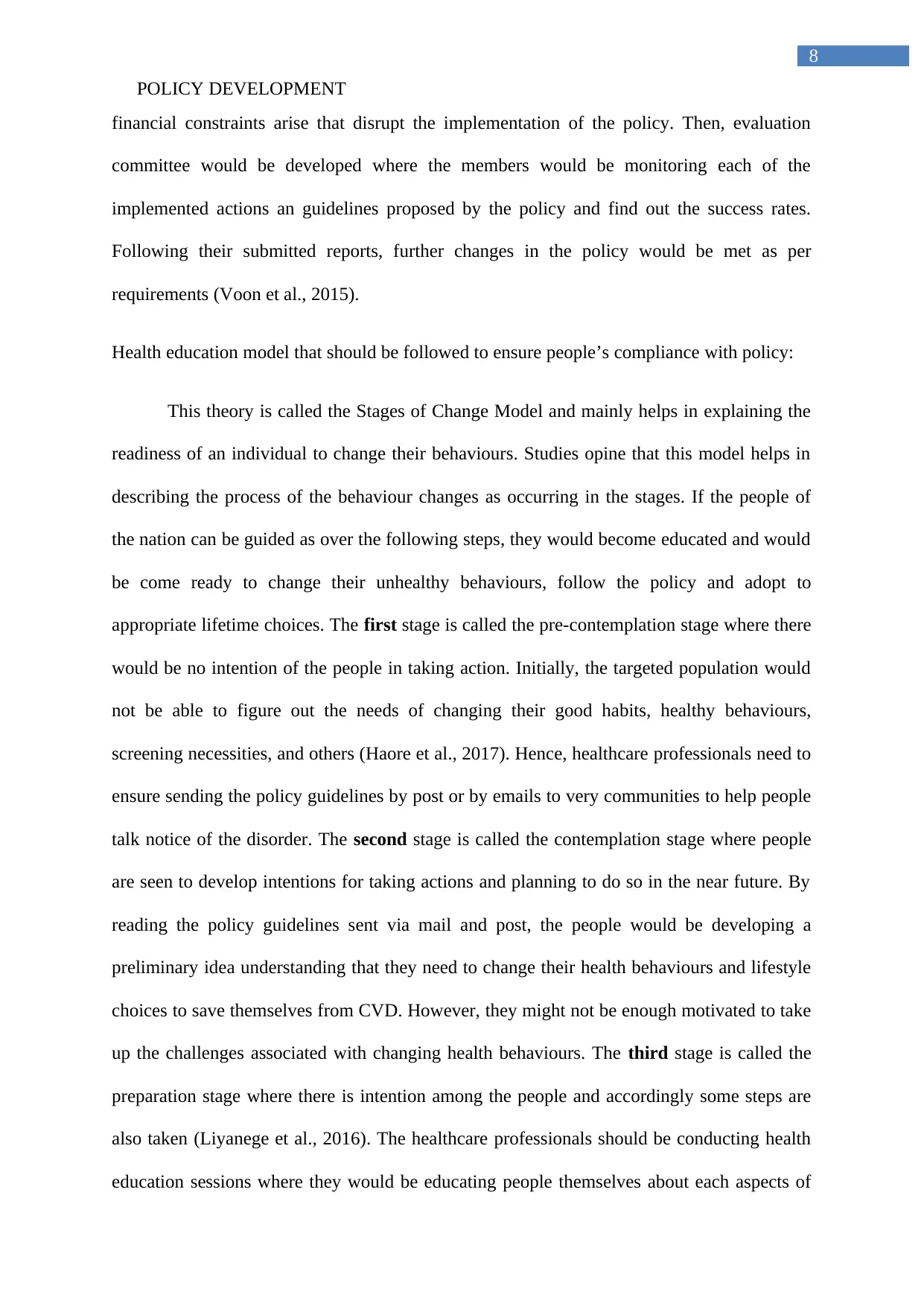
8
POLICY DEVELOPMENT
financial constraints arise that disrupt the implementation of the policy. Then, evaluation
committee would be developed where the members would be monitoring each of the
implemented actions an guidelines proposed by the policy and find out the success rates.
Following their submitted reports, further changes in the policy would be met as per
requirements (Voon et al., 2015).
Health education model that should be followed to ensure people’s compliance with policy:
This theory is called the Stages of Change Model and mainly helps in explaining the
readiness of an individual to change their behaviours. Studies opine that this model helps in
describing the process of the behaviour changes as occurring in the stages. If the people of
the nation can be guided as over the following steps, they would become educated and would
be come ready to change their unhealthy behaviours, follow the policy and adopt to
appropriate lifetime choices. The first stage is called the pre-contemplation stage where there
would be no intention of the people in taking action. Initially, the targeted population would
not be able to figure out the needs of changing their good habits, healthy behaviours,
screening necessities, and others (Haore et al., 2017). Hence, healthcare professionals need to
ensure sending the policy guidelines by post or by emails to very communities to help people
talk notice of the disorder. The second stage is called the contemplation stage where people
are seen to develop intentions for taking actions and planning to do so in the near future. By
reading the policy guidelines sent via mail and post, the people would be developing a
preliminary idea understanding that they need to change their health behaviours and lifestyle
choices to save themselves from CVD. However, they might not be enough motivated to take
up the challenges associated with changing health behaviours. The third stage is called the
preparation stage where there is intention among the people and accordingly some steps are
also taken (Liyanege et al., 2016). The healthcare professionals should be conducting health
education sessions where they would be educating people themselves about each aspects of
POLICY DEVELOPMENT
financial constraints arise that disrupt the implementation of the policy. Then, evaluation
committee would be developed where the members would be monitoring each of the
implemented actions an guidelines proposed by the policy and find out the success rates.
Following their submitted reports, further changes in the policy would be met as per
requirements (Voon et al., 2015).
Health education model that should be followed to ensure people’s compliance with policy:
This theory is called the Stages of Change Model and mainly helps in explaining the
readiness of an individual to change their behaviours. Studies opine that this model helps in
describing the process of the behaviour changes as occurring in the stages. If the people of
the nation can be guided as over the following steps, they would become educated and would
be come ready to change their unhealthy behaviours, follow the policy and adopt to
appropriate lifetime choices. The first stage is called the pre-contemplation stage where there
would be no intention of the people in taking action. Initially, the targeted population would
not be able to figure out the needs of changing their good habits, healthy behaviours,
screening necessities, and others (Haore et al., 2017). Hence, healthcare professionals need to
ensure sending the policy guidelines by post or by emails to very communities to help people
talk notice of the disorder. The second stage is called the contemplation stage where people
are seen to develop intentions for taking actions and planning to do so in the near future. By
reading the policy guidelines sent via mail and post, the people would be developing a
preliminary idea understanding that they need to change their health behaviours and lifestyle
choices to save themselves from CVD. However, they might not be enough motivated to take
up the challenges associated with changing health behaviours. The third stage is called the
preparation stage where there is intention among the people and accordingly some steps are
also taken (Liyanege et al., 2016). The healthcare professionals should be conducting health
education sessions where they would be educating people themselves about each aspects of
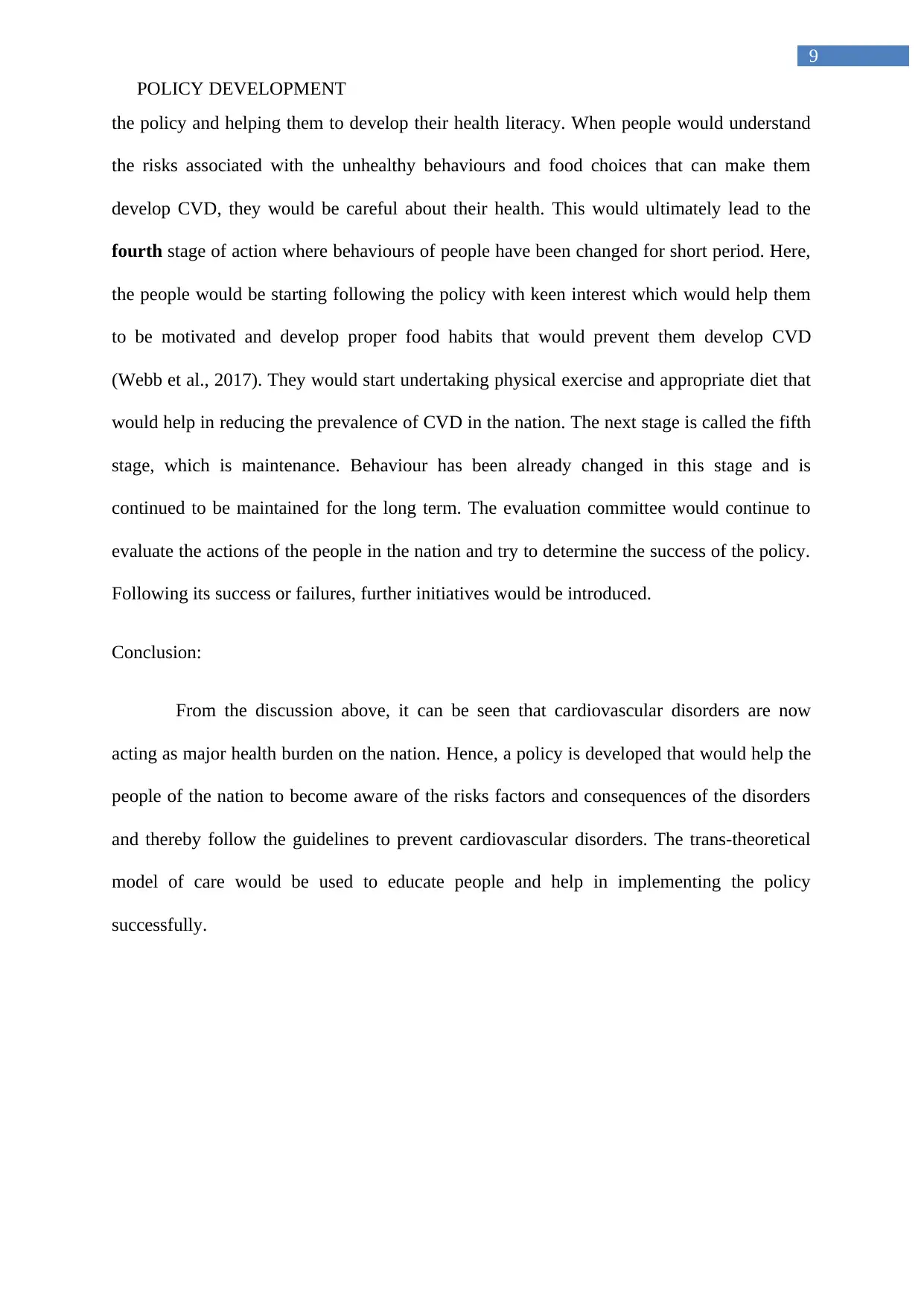
9
POLICY DEVELOPMENT
the policy and helping them to develop their health literacy. When people would understand
the risks associated with the unhealthy behaviours and food choices that can make them
develop CVD, they would be careful about their health. This would ultimately lead to the
fourth stage of action where behaviours of people have been changed for short period. Here,
the people would be starting following the policy with keen interest which would help them
to be motivated and develop proper food habits that would prevent them develop CVD
(Webb et al., 2017). They would start undertaking physical exercise and appropriate diet that
would help in reducing the prevalence of CVD in the nation. The next stage is called the fifth
stage, which is maintenance. Behaviour has been already changed in this stage and is
continued to be maintained for the long term. The evaluation committee would continue to
evaluate the actions of the people in the nation and try to determine the success of the policy.
Following its success or failures, further initiatives would be introduced.
Conclusion:
From the discussion above, it can be seen that cardiovascular disorders are now
acting as major health burden on the nation. Hence, a policy is developed that would help the
people of the nation to become aware of the risks factors and consequences of the disorders
and thereby follow the guidelines to prevent cardiovascular disorders. The trans-theoretical
model of care would be used to educate people and help in implementing the policy
successfully.
POLICY DEVELOPMENT
the policy and helping them to develop their health literacy. When people would understand
the risks associated with the unhealthy behaviours and food choices that can make them
develop CVD, they would be careful about their health. This would ultimately lead to the
fourth stage of action where behaviours of people have been changed for short period. Here,
the people would be starting following the policy with keen interest which would help them
to be motivated and develop proper food habits that would prevent them develop CVD
(Webb et al., 2017). They would start undertaking physical exercise and appropriate diet that
would help in reducing the prevalence of CVD in the nation. The next stage is called the fifth
stage, which is maintenance. Behaviour has been already changed in this stage and is
continued to be maintained for the long term. The evaluation committee would continue to
evaluate the actions of the people in the nation and try to determine the success of the policy.
Following its success or failures, further initiatives would be introduced.
Conclusion:
From the discussion above, it can be seen that cardiovascular disorders are now
acting as major health burden on the nation. Hence, a policy is developed that would help the
people of the nation to become aware of the risks factors and consequences of the disorders
and thereby follow the guidelines to prevent cardiovascular disorders. The trans-theoretical
model of care would be used to educate people and help in implementing the policy
successfully.
Secure Best Marks with AI Grader
Need help grading? Try our AI Grader for instant feedback on your assignments.
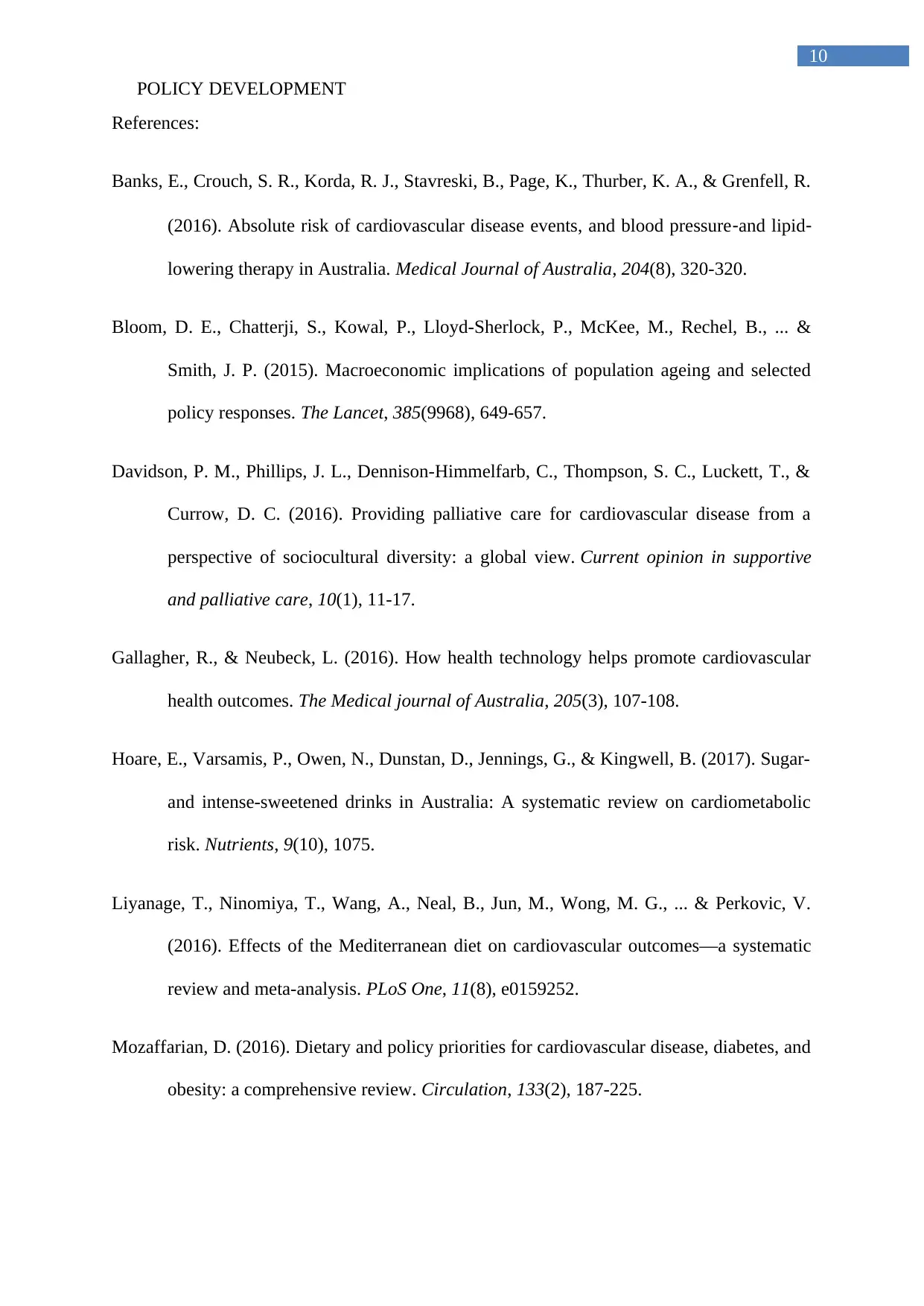
10
POLICY DEVELOPMENT
References:
Banks, E., Crouch, S. R., Korda, R. J., Stavreski, B., Page, K., Thurber, K. A., & Grenfell, R.
(2016). Absolute risk of cardiovascular disease events, and blood pressure‐and lipid‐
lowering therapy in Australia. Medical Journal of Australia, 204(8), 320-320.
Bloom, D. E., Chatterji, S., Kowal, P., Lloyd-Sherlock, P., McKee, M., Rechel, B., ... &
Smith, J. P. (2015). Macroeconomic implications of population ageing and selected
policy responses. The Lancet, 385(9968), 649-657.
Davidson, P. M., Phillips, J. L., Dennison-Himmelfarb, C., Thompson, S. C., Luckett, T., &
Currow, D. C. (2016). Providing palliative care for cardiovascular disease from a
perspective of sociocultural diversity: a global view. Current opinion in supportive
and palliative care, 10(1), 11-17.
Gallagher, R., & Neubeck, L. (2016). How health technology helps promote cardiovascular
health outcomes. The Medical journal of Australia, 205(3), 107-108.
Hoare, E., Varsamis, P., Owen, N., Dunstan, D., Jennings, G., & Kingwell, B. (2017). Sugar-
and intense-sweetened drinks in Australia: A systematic review on cardiometabolic
risk. Nutrients, 9(10), 1075.
Liyanage, T., Ninomiya, T., Wang, A., Neal, B., Jun, M., Wong, M. G., ... & Perkovic, V.
(2016). Effects of the Mediterranean diet on cardiovascular outcomes—a systematic
review and meta-analysis. PLoS One, 11(8), e0159252.
Mozaffarian, D. (2016). Dietary and policy priorities for cardiovascular disease, diabetes, and
obesity: a comprehensive review. Circulation, 133(2), 187-225.
POLICY DEVELOPMENT
References:
Banks, E., Crouch, S. R., Korda, R. J., Stavreski, B., Page, K., Thurber, K. A., & Grenfell, R.
(2016). Absolute risk of cardiovascular disease events, and blood pressure‐and lipid‐
lowering therapy in Australia. Medical Journal of Australia, 204(8), 320-320.
Bloom, D. E., Chatterji, S., Kowal, P., Lloyd-Sherlock, P., McKee, M., Rechel, B., ... &
Smith, J. P. (2015). Macroeconomic implications of population ageing and selected
policy responses. The Lancet, 385(9968), 649-657.
Davidson, P. M., Phillips, J. L., Dennison-Himmelfarb, C., Thompson, S. C., Luckett, T., &
Currow, D. C. (2016). Providing palliative care for cardiovascular disease from a
perspective of sociocultural diversity: a global view. Current opinion in supportive
and palliative care, 10(1), 11-17.
Gallagher, R., & Neubeck, L. (2016). How health technology helps promote cardiovascular
health outcomes. The Medical journal of Australia, 205(3), 107-108.
Hoare, E., Varsamis, P., Owen, N., Dunstan, D., Jennings, G., & Kingwell, B. (2017). Sugar-
and intense-sweetened drinks in Australia: A systematic review on cardiometabolic
risk. Nutrients, 9(10), 1075.
Liyanage, T., Ninomiya, T., Wang, A., Neal, B., Jun, M., Wong, M. G., ... & Perkovic, V.
(2016). Effects of the Mediterranean diet on cardiovascular outcomes—a systematic
review and meta-analysis. PLoS One, 11(8), e0159252.
Mozaffarian, D. (2016). Dietary and policy priorities for cardiovascular disease, diabetes, and
obesity: a comprehensive review. Circulation, 133(2), 187-225.
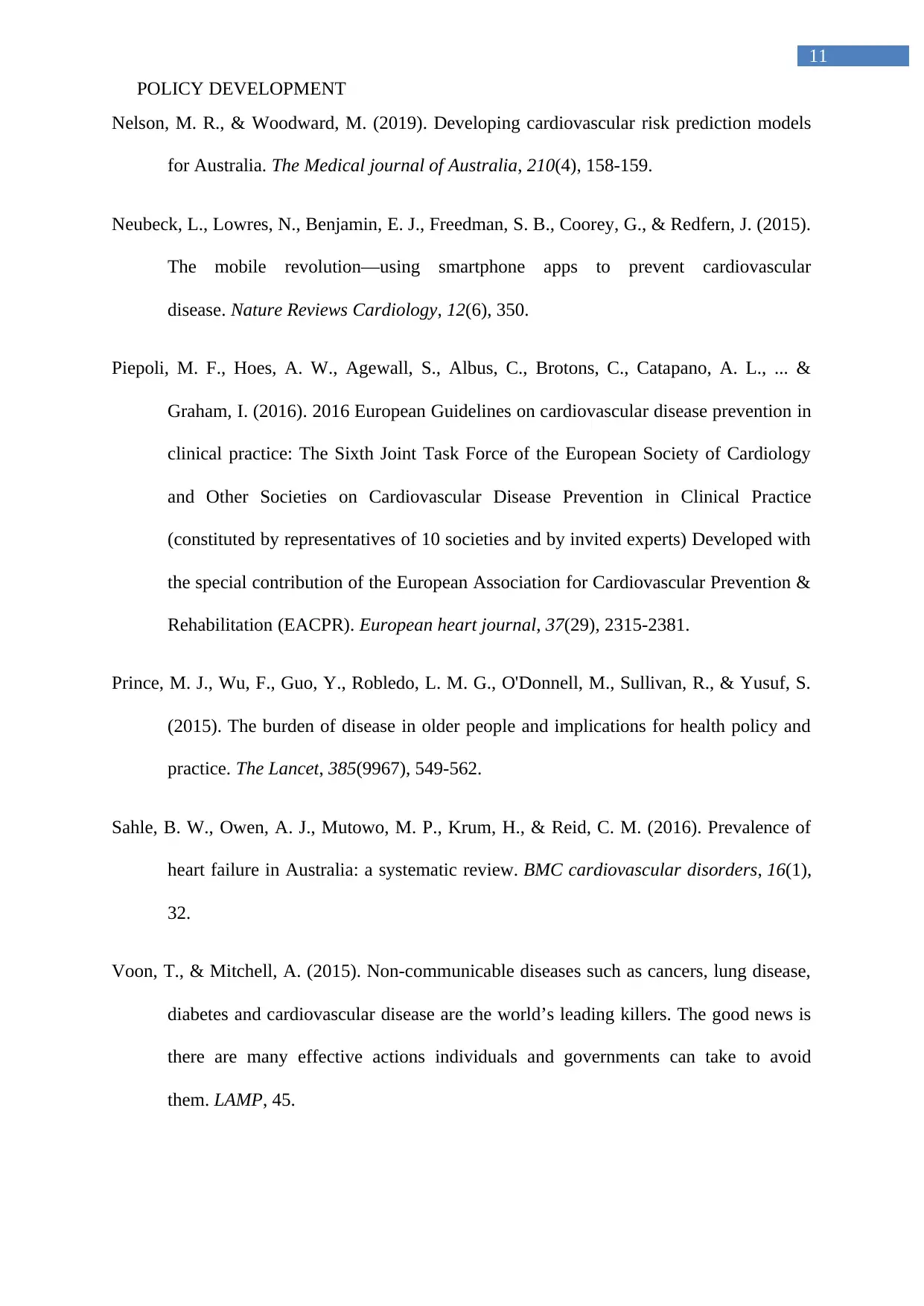
11
POLICY DEVELOPMENT
Nelson, M. R., & Woodward, M. (2019). Developing cardiovascular risk prediction models
for Australia. The Medical journal of Australia, 210(4), 158-159.
Neubeck, L., Lowres, N., Benjamin, E. J., Freedman, S. B., Coorey, G., & Redfern, J. (2015).
The mobile revolution—using smartphone apps to prevent cardiovascular
disease. Nature Reviews Cardiology, 12(6), 350.
Piepoli, M. F., Hoes, A. W., Agewall, S., Albus, C., Brotons, C., Catapano, A. L., ... &
Graham, I. (2016). 2016 European Guidelines on cardiovascular disease prevention in
clinical practice: The Sixth Joint Task Force of the European Society of Cardiology
and Other Societies on Cardiovascular Disease Prevention in Clinical Practice
(constituted by representatives of 10 societies and by invited experts) Developed with
the special contribution of the European Association for Cardiovascular Prevention &
Rehabilitation (EACPR). European heart journal, 37(29), 2315-2381.
Prince, M. J., Wu, F., Guo, Y., Robledo, L. M. G., O'Donnell, M., Sullivan, R., & Yusuf, S.
(2015). The burden of disease in older people and implications for health policy and
practice. The Lancet, 385(9967), 549-562.
Sahle, B. W., Owen, A. J., Mutowo, M. P., Krum, H., & Reid, C. M. (2016). Prevalence of
heart failure in Australia: a systematic review. BMC cardiovascular disorders, 16(1),
32.
Voon, T., & Mitchell, A. (2015). Non-communicable diseases such as cancers, lung disease,
diabetes and cardiovascular disease are the world’s leading killers. The good news is
there are many effective actions individuals and governments can take to avoid
them. LAMP, 45.
POLICY DEVELOPMENT
Nelson, M. R., & Woodward, M. (2019). Developing cardiovascular risk prediction models
for Australia. The Medical journal of Australia, 210(4), 158-159.
Neubeck, L., Lowres, N., Benjamin, E. J., Freedman, S. B., Coorey, G., & Redfern, J. (2015).
The mobile revolution—using smartphone apps to prevent cardiovascular
disease. Nature Reviews Cardiology, 12(6), 350.
Piepoli, M. F., Hoes, A. W., Agewall, S., Albus, C., Brotons, C., Catapano, A. L., ... &
Graham, I. (2016). 2016 European Guidelines on cardiovascular disease prevention in
clinical practice: The Sixth Joint Task Force of the European Society of Cardiology
and Other Societies on Cardiovascular Disease Prevention in Clinical Practice
(constituted by representatives of 10 societies and by invited experts) Developed with
the special contribution of the European Association for Cardiovascular Prevention &
Rehabilitation (EACPR). European heart journal, 37(29), 2315-2381.
Prince, M. J., Wu, F., Guo, Y., Robledo, L. M. G., O'Donnell, M., Sullivan, R., & Yusuf, S.
(2015). The burden of disease in older people and implications for health policy and
practice. The Lancet, 385(9967), 549-562.
Sahle, B. W., Owen, A. J., Mutowo, M. P., Krum, H., & Reid, C. M. (2016). Prevalence of
heart failure in Australia: a systematic review. BMC cardiovascular disorders, 16(1),
32.
Voon, T., & Mitchell, A. (2015). Non-communicable diseases such as cancers, lung disease,
diabetes and cardiovascular disease are the world’s leading killers. The good news is
there are many effective actions individuals and governments can take to avoid
them. LAMP, 45.
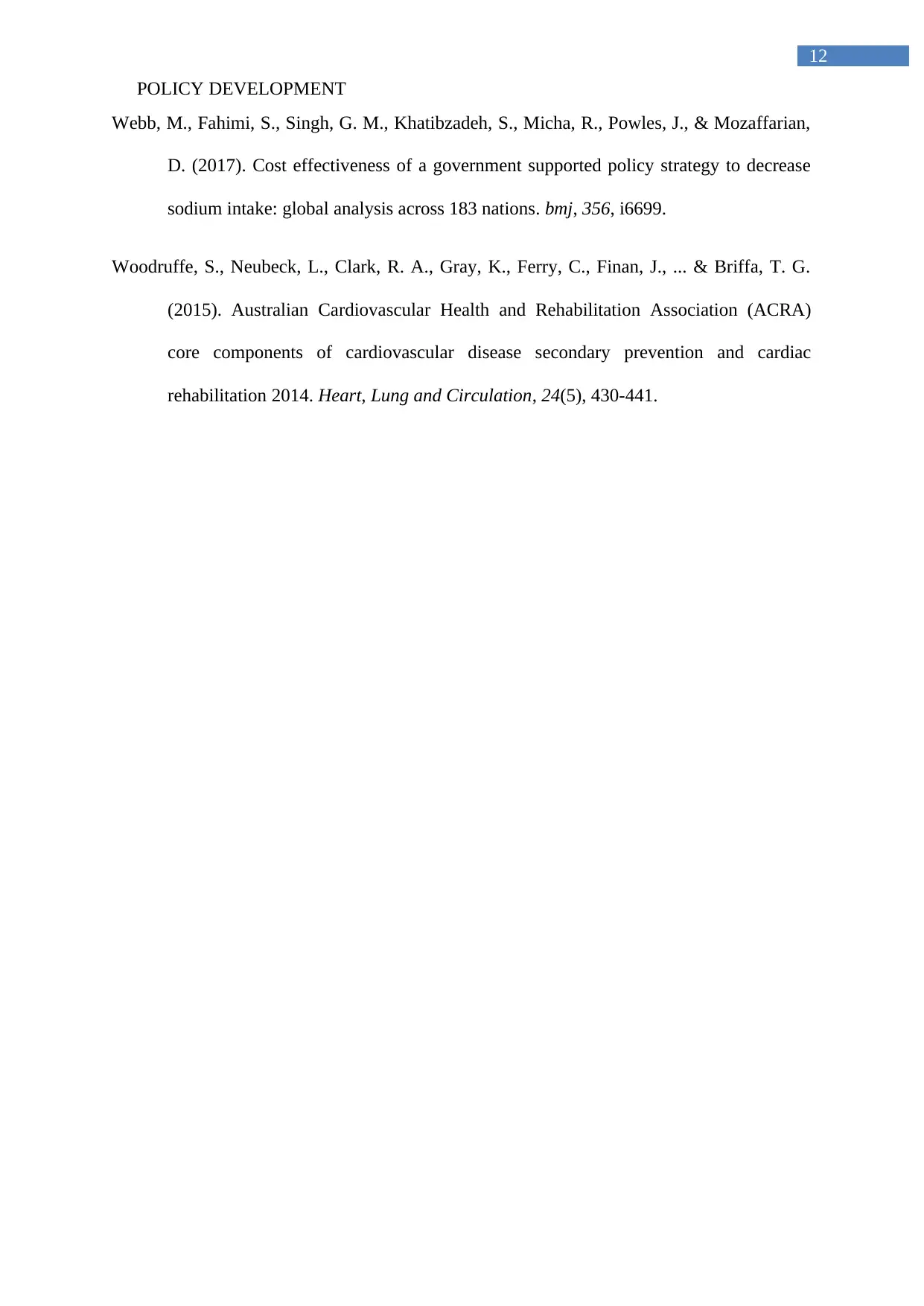
12
POLICY DEVELOPMENT
Webb, M., Fahimi, S., Singh, G. M., Khatibzadeh, S., Micha, R., Powles, J., & Mozaffarian,
D. (2017). Cost effectiveness of a government supported policy strategy to decrease
sodium intake: global analysis across 183 nations. bmj, 356, i6699.
Woodruffe, S., Neubeck, L., Clark, R. A., Gray, K., Ferry, C., Finan, J., ... & Briffa, T. G.
(2015). Australian Cardiovascular Health and Rehabilitation Association (ACRA)
core components of cardiovascular disease secondary prevention and cardiac
rehabilitation 2014. Heart, Lung and Circulation, 24(5), 430-441.
POLICY DEVELOPMENT
Webb, M., Fahimi, S., Singh, G. M., Khatibzadeh, S., Micha, R., Powles, J., & Mozaffarian,
D. (2017). Cost effectiveness of a government supported policy strategy to decrease
sodium intake: global analysis across 183 nations. bmj, 356, i6699.
Woodruffe, S., Neubeck, L., Clark, R. A., Gray, K., Ferry, C., Finan, J., ... & Briffa, T. G.
(2015). Australian Cardiovascular Health and Rehabilitation Association (ACRA)
core components of cardiovascular disease secondary prevention and cardiac
rehabilitation 2014. Heart, Lung and Circulation, 24(5), 430-441.
1 out of 13
Related Documents
Your All-in-One AI-Powered Toolkit for Academic Success.
+13062052269
info@desklib.com
Available 24*7 on WhatsApp / Email
![[object Object]](/_next/static/media/star-bottom.7253800d.svg)
Unlock your academic potential
© 2024 | Zucol Services PVT LTD | All rights reserved.





